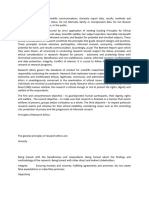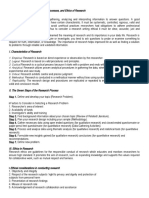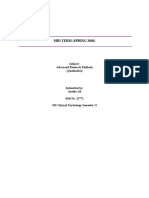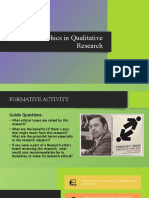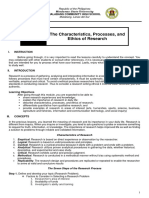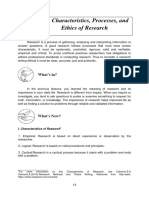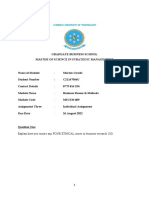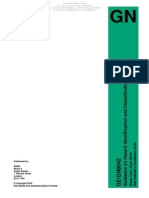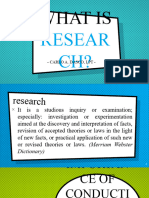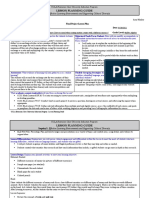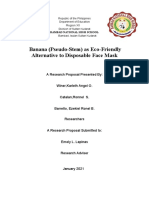Research Methods Assignment.
Question 11)
GROUP 11 MEMBERS.
MELVIN BUSERA BEPC01|0528|2021
IDAH KARENDI BEPC01|2228|2022
ROSE KASYOKI BEPC01|0009|2019
ABIUD WANYONYI BEPC01|0540|2021
DANIELLAH SAISI BEPC01|0533|2021
FRANCIS OKELLO BEPC01|0542|2021
MORRIS WACHIRA BEPC01|0527|2021
Research Ethics. 1)
Ethical concern in research means set of principles that guide your research designs and practices.
These principles are:
1. Respect for Persons -The principle, respect for persons, states that research participants should
be treated as autonomous agents—that means they are independent, self-governing, and
capable of making decisions for themselves as long as they are given sufficient information to
make those decisions.
2. Informed consent- In the consent process, people are to be given full information about the
research, both risks and benefits, and allowed to make the decision for themselves if they will
participate. A proper consent procedure should include the participant’s right to withdraw from
the study without penalty, the focus of the study and methods to be employed, statements
surrounding confidentiality, and a signature of both the researcher and the participant. The
informed consent process assumes that the research participant is competent to consent—that,
if he or she is given all relevant information, he or she will be able to comprehend the
information and be able to agree to participate in a voluntary manner that is free from coercion.
As part of the informed consent process, the researcher must disclose all relevant information
to potential participants, including the purpose of the study, the nature of the research
procedure, reasonable alternatives to the proposed intervention (if the intervention provides a
service or treatment such as in medical research), and any risks, benefits, or uncertainties of the
intervention.
3. Nonmaleficence and Beneficence -Nonmaleficence (no avoidable harm should be done to
participants) and beneficence (the outcome of research should be positive and beneficial)
maintain that research is ethical if the “benefits outweigh the potential for harm”. Sometimes,
participants may experience emotional or psychological harm that cannot be measured or may
be delayed.
� The principle of beneficence refers to making efforts to secure the well-being of research
participants, or to maximize the possible benefits of the research and minimize its possible
harm. The key to this principle is, since all research has both risks and benefits, to make sure
they balance or that benefits outweigh potential harms. Benefits to research might include a
monetary incentive for participation, a relationship with the researcher or other participants,
knowledge or education gleaned from participation, or the opportunity to do good for society.
The principle of nonmaleficence says that no individual shall be intentionally injured in the
course of the research.
4. Anonymity and confidentiality- The research must always protect a participant’s right to privacy
through anonymity or confidentiality of responses, unless the participant gives permission to
waive confidentiality. Anonymity means that no one, including the researcher, can connect the
participant’s responses with his or her identity. An example of anonymous research is a survey
in which participants do not release their names or chat groups in which people don’t use their
real names. Sometimes for anonymity no one, including the researcher, can connect a
participant’s responses with his or her identity. Confidentiality means that, although the
researcher knows what each participant said (or can find out this information), the participant’s
identity is kept secret when reporting or writing up the findings. Justice This principle takes a
slightly different point of view of research participants, because it looks at who is included as
research participants and who is excluded. This principle says that all classifications of people
(race, ethnicity, gender, age, etc.) should receive equal treatment in terms of risks and benefits
associated with the research. Certainly, including only people of one ethnicity in research that
subjects them to harm is not just. However, excluding people of a certain ethnicity in research
that might help them is equally unjust. Risks and benefits should be distributed fairly and
without bias, and people should be included or excluded in research only for reasons that have
to do with the research question or hypothesis.
5. Including Participants in Co-Constructed Research- There are the issues of legitimation (Who
can speak for these people?) and representation (How can you speak for these people?).
Representation refers to understanding fully the lived experiences of research participants and
including the multiple realities, interpretations, experiences, and voices emergent from all
individuals and all angles. One challenge is to ensure that the people and context studied are
adequately and sufficiently represented, and that rigorous attempts are made to include their
own voices and interpretations. Methods that directly include—and help researchers more fully
understand—participants’ voices and interpretations might include interactive techniques such
as interactive interviewing, interactive focus groups, constructed narratives, or close observation
over a long period of time which allow study participants to give their own accounts of their
own experiences. Other advantages of coauthored methods include the possible avoidance of
obtaining consent (since participants are also researchers), alleviation of concerns about
offending subjects, and less likelihood of research participants changing their minds about
participating. Qualitative researchers should also ensure that they are representing the voice of
their participants by conducting member checks at the conclusion of their study. Member
checks consist of a process of providing study participants with the research findings and giving
them the opportunity to voice agreement or disagreement with the research as reported.
�6. Objectivity -Ensuring that the research is conducted impartially and without bias to provide
accurate and reliable findings to the client. Making sure both the parties stay in the topic and
not to ask or answer questions that are out of topic that was to be discussed.
2) Importance of ethical decision making
There are several reasons why it is important to adhere to ethical norms in research.
1 Norms promote the aims of research, such as knowledge, truth, and avoidance of error. For
example, prohibitions against fabricating, falsifying, or misrepresenting research data
promote the truth and minimize error.
2 Since research often involves a great deal of cooperation and coordination among many
different people in different disciplines and institutions, ethical standards promote the
values that are essential to collaborative work, such as trust, accountability, mutual respect,
and fairness. For example, many ethical norms in research, such as guidelines for
authorship, copyright and patenting policies, data sharing policies, and confidentiality rules
in peer review, are designed to protect intellectual property interests while encouraging
collaboration.
3 Most researchers want to receive credit for their contributions and do not want to have
their ideas stolen or disclosed prematurely. Many of the ethical norms help to ensure that
researchers can be held accountable to the public. For instance, federal policies on research
misconduct, conflicts of interest, the human subject’s protections, and animal care and use
are necessary in order to make sure that researchers who are funded by public money can
be held accountable to the public.
4 Ethical norms in research also help to build public support for research. People are more
likely to fund a research project if they can trust the quality and integrity of research.
5 Respect for others - respecting the rights dignity and autonomy is fundamental to ethical
decisions. This involves considering how one's actions may impact others and treating them
with fairness and Integrity.
6 Awareness of consequences - considering the potential outcome and consequences of
different choices, ethical decisions aim to minimize harm and maximize benefits for all
affected parties.
7 Openness to feedback - being receptive to feedback and willing to reconsider one's in light
of new information or perspectives, helping in making more informed ethical decisions.
Question 3) Ethical concern for the respondents
The main role of human participants in research is to serve as sources of data. Researchers
have a duty to ‘protect the life, health, dignity, integrity, right to self-determination, privacy
and confidentiality of personal information of research subjects. The ethical concerns are:
1) Informed consent- Informed consent means that the person participating in the
evaluation is fully informed about the evaluation being conducted. Respondents need to
be made aware of the purpose of the project, who or what group is funding it, how the
� findings will be used, if there are any potential adverse impacts of their participation
and who will have access to the findings. The main purpose of informed consent is that
the respondent is able to make an informed decision as to whether they will participate
in the evaluation or not.
2) Voluntary participation- Voluntary participation means that people participate in the
evaluation free from coercion. Participants are free to withdraw their participation at
any time without negatively impacting on their involvement in future services or the
current program and relationships with any of the researchers or research bodies
involved. It is the right of participants to leave a research program at any time,
therefore no pressure should be placed on those who choose not to continue.
3) Do no harm- Harm can be both physical and/or psychological and therefore can be in
the form of: stress, pain, anxiety, diminishing self-esteem or an invasion of privacy. It is
imperative that the evaluation process does not in any way harm (unintended or
otherwise) participants.
4) Confidentiality- Confidentiality means that any identifying information is not made
available to, or accessed by anyone but the program coordinator. Confidentiality also
ensures such identifying information is excluded from any reports. Given that there are
often small numbers in peer based programs, it is very important to consider how
reports are worded to ensure that there is no opportunity for people to be identified
even though names are not used.
5) Respect for Persons -The principle, respect for persons, states that research
participants should be treated as autonomous agents—that means they are
independent, self-governing, and capable of making decisions for themselves as long as
they are given sufficient information to make those decisions.
6) Fair treatment- Treating all participants fairly and avoiding discrimination or biasness on
factors such as age, gender, race or socioeconomic status.
7) Data security- Implementing secure measures to protect participants' data from
unauthorized access or unintended.
Question 4) Obligations and Rights of researchers
(a) Obligations
1) Ethical Conduct: Researchers have an obligation to adhere to ethical standards in all aspects of
their work. This includes obtaining informed consent from participants, ensuring privacy and
confidentiality, and avoiding any form of deception or harm.
2) Integrity in Reporting: Researchers must accurately and transparently report their methods,
results, and conclusions. Fabrication, falsification, or selective reporting of data is a breach of
integrity and undermines the trustworthiness of scientific knowledge.
3) Respect for Participants: Researchers are obligated to treat their study participants with respect
and dignity. This involves considering the well-being of participants, protecting their rights, and
addressing any potential conflicts of interest that may arise during the research process.
�4) Compliance with Regulations: Researchers should comply with applicable laws and regulations
governing their field of study. This includes obtaining necessary approvals from ethics
committees or institutional review boards and following guidelines for responsible conduct of
research.
5) Openness and Collaboration: Researchers are encouraged to promote openness in their work by
sharing data, methodologies, and results. Collaboration with other researchers fosters a
collaborative and transparent research environment, contributing to the advancement of
knowledge.
b) Rights
1) Right to Academic Freedom: Researchers have the right to pursue their research interests and
express their findings without undue interference. Academic freedom allows researchers to
explore diverse topics and present their work without fear of censorship.
2) Right to Authorship and Recognition: Researchers have the right to be recognized as the authors
of their work. This includes acknowledgment for their intellectual contributions and the right to
control the publication and dissemination of their research findings.
3) Right to Informed Consent: Researchers have the right to obtain informed consent from
participants before involving them in a study. This ensures that participants are fully aware of
the research's purpose, procedures, potential risks, and benefits before agreeing to participate.
4) Right to Privacy and Confidentiality: Researchers have an obligation to protect the privacy and
confidentiality of study participants. This includes safeguarding sensitive information and
ensuring that individuals cannot be identified in research reports without their explicit consent.
5) Right to a Fair and Impartial Review: Researchers have the right to a fair and impartial review of
their work by peers, funding agencies, and ethical review boards. This process helps maintain the
quality and credibility of research by subjecting it to rigorous evaluation from knowledgeable
experts in the field.
6) Right to intellectual property - researchers have the right to associate with their research
including patent, copyrights and trademarks.
7) Right to safety - researchers have right to a safe working environment and to be protected from
physical harm or harassment.
8) Right to fair compensation for their work including recognition and finance compensation for
their contributions.
Rights and obligations of clients.
1) Informed Consent: Clients have the obligation to provide informed consent before participating
in research. This involves being fully aware of the purpose, procedures, potential risks, and
� benefits of the study, enabling them to make a voluntary and knowledgeable decision about
their involvement.
2) Honesty and Accuracy: Clients should provide accurate and truthful information during the
research process. Providing honest responses ensures the integrity of the study and helps
researchers draw valid conclusions from the data collected.
3) Compliance with Protocols: Clients are obligated to follow the research protocols and guidelines
established by the researchers. This includes adhering to specific instructions, procedures, and
any agreed-upon conditions to ensure the study's consistency and reliability.
4) Confidentiality: Clients have a right to expect their information to be kept confidential.
Researchers, in turn, have an obligation to safeguard participants' privacy by not disclosing
personal details without explicit consent, unless required by law or ethical standards.
5) Communication with Researchers: Clients should maintain open and clear communication with
researchers throughout the study. This involves promptly addressing any concerns, asking
questions for clarification, and informing researchers of any changes in their circumstances that
might impact the study. Effective communication helps ensure a collaborative and ethical
research process.
b) Rights
1) Informed Consent: Clients have the right to be fully informed about the purpose, procedures,
potential risks, and benefits of the research before agreeing to participate. Informed consent ensures
that individuals make a voluntary and knowledgeable decision to take part in the study.
2) Privacy and Confidentiality: Clients have the right to have their personal information protected.
Researchers must maintain confidentiality, ensuring that participants' data is kept secure and not
disclosed without explicit consent, unless required by law.
3)Voluntary Participation: Clients have the right to participate in research voluntarily. They should not
be coerced, pressured, or influenced unduly to take part. Researchers must respect participants'
autonomy and provide the option to withdraw from the study at any time without facing negative
consequences.
4)Beneficence and Non-Maleficence: Clients have the right to be treated ethically, with their well-being
prioritized. Researchers should strive to maximize benefits and minimize harm. This includes considering
potential risks and taking steps to protect participants throughout the research process.
5)Debriefing and Feedback: Clients have the right to receive feedback and information about the results
of the study, if desired. Researchers should provide a debriefing session, explaining the purpose,
outcomes, and addressing any questions or concerns participants may have after their involvement in
the research.
Question 5) Referencing in research.
Referencing is how you acknowledge the source of the information you have used (referred to) in your
work. It helps to make clear to the reader how you have used the work of others to develop your own
ideas and arguments.
�Different types of referencing.
1) The Harvard referencing style
This style of research typically refers to the Harvard referencing system, a widely used citation
style in academic writing. It involves citing sources in the text and creating a comprehensive
reference list and it includes the author's last name and the publication year in the parentheses.
For example, Johnson M. (2010) effective communication in Academic writing, Journal of writing
studies,15(2) 123-145.
Smith J. (2010) the impacts of climate change on Global ecosystem. Publisher.
2) APA referencing style
It means American Psychological Association and is widely used in schools and sciences.
Example: APA referencing style: Author’s last name, Initial(s). (Year of publication). Title of book.
Publisher.
Kaul, L (2010). Methodology of Educational Research. Vikas Publishing House.
APA referencing style (More than 3 Authors):
Author’s last name, Initial(s)., Author’s last name, Initial(s)., &Author’s last name, Initial(s). (Year
of publication). Title of book. Publisher.
Smith, T., Williams, B. M., & Street, R. (2020). Educational Research. Harper Collins.
3) MLA referencing style
MLA stands for the Modern Language Association. It is the principal professional organization of
language and literature scholars. MLA style citations are commonly used by students and
academics in the humanities.
•Author’s last name, First name. Title of Book. Publisher, year of publication.
Santrock, John. Educational Psychology. McGraw-Hill Education,2017.
MLA referencing, more than one author,
Author’s last name, First name, and Author’s first name Last name. Title of Book. Publisher, Year
of publication. Smith, Thomas, and Barbara Michelle Williams. The Citation Manual for Students:
A Quick Guide. Wiley,2021.
4) American Medical Association (AMA)
AMA is an author-number style, which means a number is placed in the text to correspond to
the author name(s) in the reference list, which are listed numerically in order of appearance. It is
commonly used in the medical and scientific fields. Each reference is separated into bibliographic
groups by a period. Within each group, commas, semi-colons, or colons are used. Formatting-
AMA style generally follows a straightforward numerical format for citations and a consistent
layout for reference entries.
� For example: Smith AB, Johnson CD. The role of exercise in cardiovascular health. J Am Heart
Assoc. 2023;12(4): e045678. doi:10.1234/jaha.2023.045678.
In this example: Smith AB and Johnson CD are the authors. "The role of exercise in
cardiovascular health" is the title of the article. "J Am Heart Assoc" is the abbreviated journal
name (Journal of the American Heart Association). 2023 is the publication year. Volume 12, Issue
4, pages e045678. DOI (Digital Object Identifier) is provided if available.
5) Chicago referencing style
Chicago is a citation style used in academic writing to provide sources of information and ideas.
It is widely used in various discipline including history, literature and arts. It has two main
documentations;
(a) The notes and biography system. For example; Brown Susan," Urban development in the
21st century "city studies 35(2015):123-145
(b) The author- date system. For example: Brown Susan 2015."Urban development in the 21st
century."city studies 35: 123 -145v





